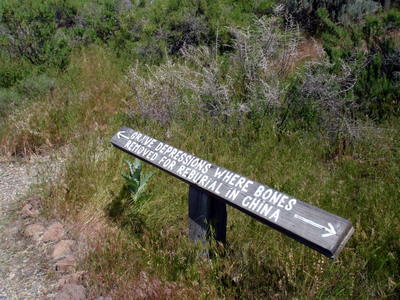Disinterment: A Historical Ritual

Baker City Chinese Cemetery wooden marker, added in recent years, which reads "Grave depressions where bones removed for reburial in China"
Photo Credit: Tom Banse
A Historic Tradition Practiced in a New Land
Although Chinese death rituals are complex and vary based on region and class, the majority of Chinese who immigrated to the United States brought their funerary practices and beliefs with them. They especially brought with them the belief in the continuity between this life and the afterlife and the need for their remains to be cared for by their family. Therefore, the need to be disinterred and shipped back China to be reunited with family was eminent.
~~~~~~~~~~~~~~~~~~~~~~~~~~~~~~~~~~~
Chung, Sue Fawn and Priscilla Wegars, eds. Chinese American Death Rituals: Respecting the Ancestors. Lanham, MD: AltaMira Press, 2005.
Archeological documentation of Chinese death rituals date back to the beginnings of Chinese civilization, and Chinese American funerary customs can be traced back to those early traditions. Various concepts of community, nature, and the afterlife, within the three major religions in China: Confucianism, Daoism, and Buddhism merged to form Chinese burial practices that continue to the present day.
Disinterment, the exhumation of a person’s remains from the grave, is a part of the cycle of Chinese funerary customs. After a person’s death, it is common practice to have elaborate funeral ceremonies before the body is removed to the burial place. The first burial, however, is not meant to be permanent. At a later date, the remains are disinterred and placed in an urn to then be reburied after the erection of a permanent tomb. Also, though not practiced in all regions of China, fengshui is used to choose a burial site that is in harmony with nature.
In Chinese belief a person has two souls and in death, one ascends to heaven and the other remains on earth. In order for the deceased’s relatives and future descendents to attain good fortune, they were to properly care for their ancestor’s spirit. There are numerous funeral customs practiced to appease both good and evil spirits. During a funeral procession attendees distract the evil spirits by playing music and scattering paper with holes so that the spirits will have to focus on passing through those holes and be unable to learn where the deceased was buried. At the burial site, friends and relatives symbolically transmit wealth to the deceased by burning paper money, personal
items, and clothing, and sometimes making offering such as
food and liquor. The Qingming festival, held annually in the
spring, is a time to venerate the dead by visiting burial sites, cleaning graves, and offering items to appease the spirits.
